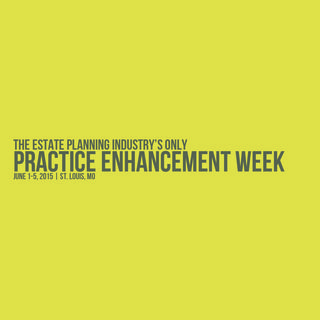Recently we had a member complain that our system "didn't work the way he wanted it to”. We later discovered he was on the ListServ of another major estate planning organization and referred to one of our planning templates for designing and drafting our trusts.
Immediately, many people on the ListServ requested a copy of the template, which he kindly obliged. Aside from violating his licensing agreement and being guilty of conversion, he did not even understand and appreciate the value of what he was providing, while those requesting it, did.
 So let's examine why templates are so powerful. Typically, templates are used as a guide for us to create legal documents. The challenge is, most documents are lawyer centered and the template is merely a reflection of the document “options” to ensure you know what options to include. I believe a template should be used to guide the attorney to counsel the client on all options available to achieve the client goals, not just the specific provisions allowed or limited in a particular document creation program. That's where properly drawn templates are extremely powerful.
So let's examine why templates are so powerful. Typically, templates are used as a guide for us to create legal documents. The challenge is, most documents are lawyer centered and the template is merely a reflection of the document “options” to ensure you know what options to include. I believe a template should be used to guide the attorney to counsel the client on all options available to achieve the client goals, not just the specific provisions allowed or limited in a particular document creation program. That's where properly drawn templates are extremely powerful.
A properly drawn template must match and tie to the software that actually generates the document and must allow the attorney to utilize any design choice the attorney deems appropriate to achieve the client’s goal. Lawyers with Purpose document templates, have unlimited customization ability that integrates 100% with the software to accommodate it. So rather than being restricted to the options in a typical document instead, a properly created template that's integrated with the software will permit true customization at every element of design in the document being created. A proper template will not only allow you to custom design each and every document to the needs to the client, but more importantly, integrates the custom design into all of the different legal documents together with a single entry.
Our templates integrate all legal issues for the client to consider and when used with the software generates all documents to complete the clients plan with the customizations. This is consistent with the way clients think and more importantly, takes each of the custom drafting options of the client and properly integrates them across all different planning documents with one single entry and one single template. This creates not only better plans, but a more efficient way of designing and drafting them to accomplish the clients overall goals.
Perhaps the greatest benefit of a powerful template is when you make choices on it and when it's implemented into the software, it warns you of inconsistent choices that you have made that threatens the overall plan you've selected for the client. This is where the power of artificial intelligence in the LWP client-centered document creation system is so critical. By using the template it guides the attorney to all of the various counseling issues available to a client in each area of their life. Thereafter choosing the options that are most helpful for the client the template is then shared with a paralegal or drafter in your office who will then translate it into the software to create the will, healthcare proxies, powers of attorney, personal care plan, revocable trust, and irrevocable trust, all from a single entry. What's more powerful, are the custom choices the client makes are integrated into each of those documents, with a single client interview and single entry into the software. As further protection, if the attorney chooses to elect different variable in the planning strategy that are inconsistent with the overall goal of the client the software maintains and keeps track of all choices to alert the attorney if he has created a scenario that might put the client's overall objectives and goals at risk.
So how important and effective can templates be? Can you imagine the power of templates when they're properly designed and integrate with the document creation system? Discover the power of templates to you and your clients and how to utilize them to integrate the planning strategy to achieve client’s goals.
To learn more about our templates and our systems and processes to support your estate and elder law practice, join our Practice Enhancement Event in St. Louis in June. You can check out the full agenda here and see all that it has to offer your estate planning and elder law practice and your team. You do not want to miss this event!
David J. Zumpano, Esq, CPA, Co-founder Lawyers With Purpose, Founder and Senior Partner of Estate Planning Law Center










